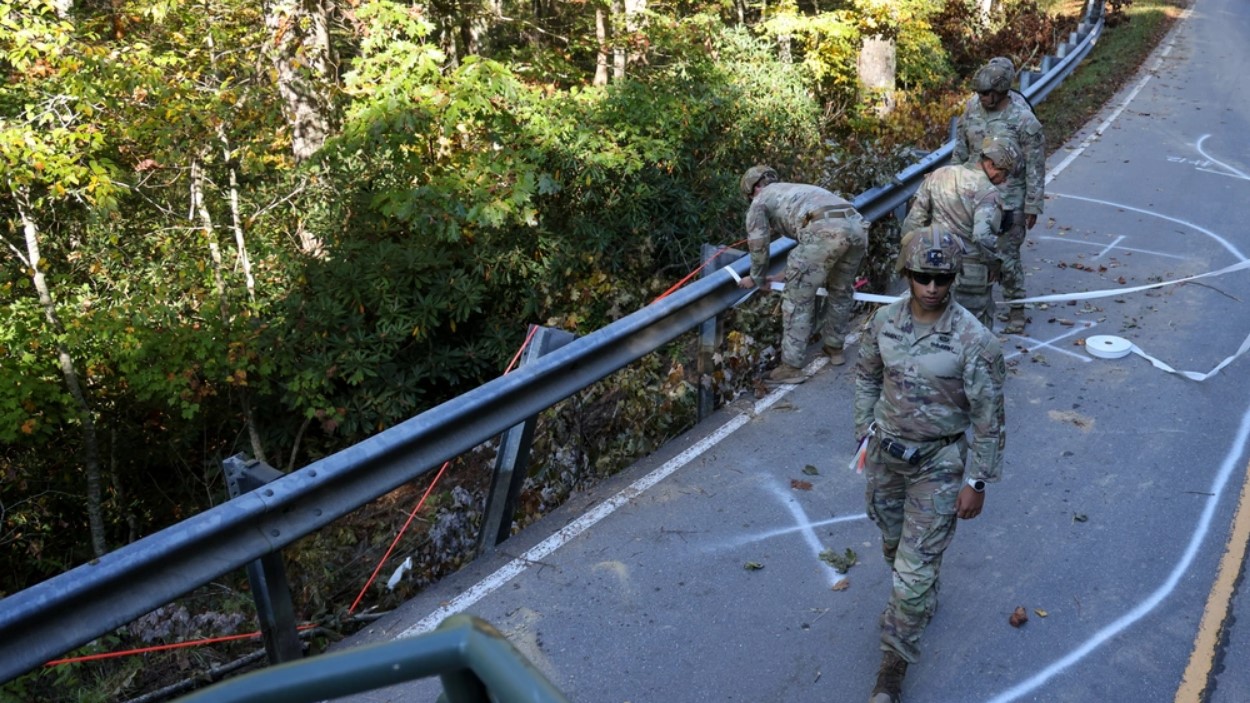

More than 1,000 active-duty soldiers with the 101st and 82nd airborne divisions are on the ground and in the skies above North Carolina, working to help local National Guard units and emergency responders aid communities impacted by Hurricane Helene.
As of the weekend, more than 7,000 service members from the United States Army and the National Guard are active across the southeast. The National Guard units from 16 states were joined by active-duty soldiers mobilized by the XVIII Airborne Corps, with the express mission of “reaching the hardest hit areas as quickly as possible,” the Department of Defense said.
Roughly 500 soldiers with the 20th Engineer Brigade, XVIII Airborne Corps and the 82nd Combat Aviation Brigade, 82nd Airborne Division left Fort Liberty on Oct. 3 for Asheville, the largest city in western North Carolina and part of Buncombe County, one of the most damaged parts of the country by Helene. They are conducting inspections of the roads in the region, as well as clearing debris and transporting supplies. Several aircraft were deployed with them for the mission.
More than 500 soldiers with the 101st Airborne Division deployed to western North Carolina on Saturday, Oct. 5. They brought at least 60 Infantry Squad Vehicles, and more than 15 helicopters to the area as well, for troop transport and to move supplies. The soldiers with Task Force Falcon will be focused on a variety of roles, including search and rescue, traffic control and clearing roads of debris. The active-duty troops will also prioritize the last step of getting aid to communities, transporting it from staging areas to “the point of need,” according to the Department of Defense.
Helene made landfall on Sept. 26 as a Category 4 hurricane and in the days that followed tore through the southeast, flooding communities, forcing large evacuations — including some at military bases along the path of the storm — and leaving a trail of destruction.
Subscribe to Task & Purpose Today. Get the latest military news and culture in your inbox daily.
The soldiers from the two airborne divisions are part of the wider military response to the damage done by Helene. As of Oct. 6, more than 6,700 National Guard troops from more than a dozen states have been deployed to the southeast, working with the Federal Emergency Management Agency to coordinate recovery efforts.
“Resources from around the nation are at work helping western North Carolina’s storm response and recovery,” North Carolina Gov. Roy Cooper said in a statement on Oct. 5.
As the days since the storm passed have gone on, the National Guard and its partners are moving away from search and rescue missions and towards debris clearing and logistical support. The U.S. Army Corps of Engineers also has personnel on the ground working on getting wastewater facilities fully operational.
The death toll from Helene nationwide is currently at least 213 across six states, with 106 of those reported in North Carolina. That is still expected to rise as emergency responders reach cut off areas.
Soldiers with the 101st Airborne also touched down to deliver supplies to parts of eastern Tennessee over the weekend, another area hit hard by Helene.
Hundreds of thousands remain without power, and many roads are still blocked by debris. Contaminated water also remains a problem, with the Asheville area potentially being without clean, running drinking water for weeks. FEMA teams and their partners have so far delivered more than 6 million liters of water. Due to the area’s mountainous terrain and blocked roads, aerial transport remains the most effective way to get supplies to cut off communities, or rescue people in need.
The latest on Task & Purpose
- Marine sergeant major fired from West Coast bootcamp now in brig amid investigation
- Army sends troops, artillery to the Aleutian Islands as Russian planes again fly near Alaska
- Marine who died trying to reach trapped Osprey pilots honored for final bravery
- Former West Point garrison commander cleared of most charges that led to firing
- Navy’s first fully gender-integrated submarine joins the fleet. Here’s what that means
